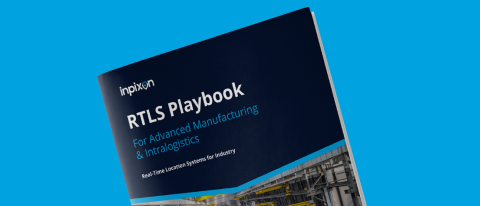Industrial environments often feature a combination of metal materials (racks, machines, shelves, etc.) and biological materials (food, people, and chemicals) that are predisposed to interfere with or block radio frequency (RF) signals. While building digital warehousing or managing logistics of yard management, many organizations struggle to develop fully functional RTLS within their facility without compromising performance.
One of the keys to a robust RTLS is to ensure that it’s powered by the right RF technology for your facility. This is because each type of RF signal has unique properties regarding the distances they cover, the accuracy with which they can pinpoint the location of an asset, and the materials they can bypass.
For example, here’s how chirp, a specific type of radio frequency, stands out in the RF landscape:
- Longer range than most RF technologies - accessibility up to 1000 meters
- Protection against radio frequency interference
- Indoor and outdoor stability
- Fewer anchors are required for deployments, providing excellent ROI
- Low cost due to worldwide usability, furthering your ROI
- Real-time positioning
- Location accuracy of 1-2 meters
Safety in Any Industry
Chirp is exceptionally well suited to support collision avoidance scenarios where workers, forklifts, automated guided vehicles (AGV), and Autonomous Mobile Robots (AMRs) interact in the same environment. Chirp technology provides the outstanding capability to reliably detect approaching assets, even in highly industrial environments with intense metal exposure.
The technology can be used indoors and outdoors for safety applications 24/7 with multiple ranging applications, making Chirp a viable option for digital warehousing, logistics, and yard management.
Also, by using Chirp, you can complement your existing chirp based collision avoidance solution with RTLS infrastructure (RTLS anchors plus a location engine and IoT Platform) and add full location transparency through the digital twin, to add the capacity to extract the actual business value from the already tagged assets. The beauty of this approach is that while you build up a safety layer into your business, you can later upgrade and re-use the existing solution to add process transparency and optimization by combining location awareness with business context data.
Chirp Supports Digital Transformation in Warehousing, Logistics, and Yard Management
Now, the good stuff. There’s no need to rely solely on inventory count because you can see precisely where each of your assets is located and track them as they move. With Chirp, you add process visibility and enable streamlining of siloed transport processes. Chirp can help control if assets are allowed in specific locations around or within your facility.
Worldwide warehouses? No problem. Chirp builds an excellent foundation for asset tracking due to its ISM Band 2.4 GHz usage. This means Chirp can be deployed virtually everywhere without any regulatory or licensing limitations.
In digital warehousing, Chirp technology can be used for safety measures for personnel and equipment. It helps track goods, forklifts, load carriers, equipment, and larger items like bins where you store/package smaller items such as plane parts, turbine parts, engines, pallets, and containers on a 1-2 meter level.
Chirp is a practical, reliable, and cost-effective option for tracking engines, vehicles, plane or ship components, as well as for pallets, containers, and trollies.
Exploring Chirp for Logistics
Logistics require indoor and outdoor compatibility of the tracking technology to ensure a seamless transition from end to end to support the inbound goods receive and outbound process. Chirp is known for its unique ability to work indoors and outdoors across long ranges. Even the most widely used GPS technology has some limitations, like its often limited real-time capability and its need for unobstructed line of sight.
Chirp can add a second layer of reliability for comprehensive outdoor coverage like roofed storage access areas or areas that simply shadow away satellites to get a proper link with tall halls, silos, hills, or other structures like open pit mines, tunnels, underground mines, underground storage, or production facilities systems.
Chirp Spread Spectrum adds end-to-end location information with reliable meter-level accuracy during transport from finished assembly goods to the yard. By connecting this location data to an IoT platform, logistics managers can gain insight into what areas of the logistics process can be improved. Where are there slowdowns, delays, or blocked paths? How can you optimize your space to speed up processes and get more done in less time? Digital Warehousing has never been easier.
Using Chirp can help you gain a complete overview of your facilities and provide transparency over operations that you haven’t had before, empowering you to make the best decisions for your business.
Applying Chirp in Yard Management
In the yard, tracking gaps, where you lose the signal for a moment, are quite normal. While transporting goods, vehicles, or containers from indoors to outdoors, a pure GPS or cell-based tracking solution is not always acceptable or reliable enough to deliver location data near buildings.
Transmitting the location data back to a server over a cell network adds recurring costs, which is not the case with Chirp. Therefore, CSS is a complementary technology to existing indoor technology. Using it in the yard is ideal without relying on GPS or cell. In contrast to GPS, there is no start-up time to get a link with Chirp. There are obstructions in Yard Management called blind spots, which are easy remedies with a Chirp solution because you can easily add anchors where needed.
With GPS, you can also run into battery runtime issues if you need more real-time information, as GPS devices consume a large amount of energy to function this frequently. Chirp enables a gapless tracking infrastructure for location information on demand from indoor to outdoor monitoring. Chirp extends the yard transparency with ease due to the long Chirp ranges of 300m-500m with comparable low infrastructure costs.
By comparison, UWB is regulatorily restricted to indoor usage. Regulations restricting UWB usage for outdoor tracking are a frequent hurdle for organizations that need to continue monitoring beyond their facility. These regulations prohibit UWB from outdoor tracking across multiple countries, such as Germany, Austria, Switzerland, etc. Chirp is not restricted at all under the same regulations and requires no licensing to utilize.
Getting Started with Chirp
Start with a safety solution using ranging and expand on this with RTLS technology and an IoT platform. Chirp suits a variety of scenarios where reliability is of utmost importance, and organizations can benefit from:
- End-to-end traceability for assets from raw materials to finished products
- Automated control of plant logistics through geofences
- Enable Process and material flow analyses
- Eliminate manual, paper-based processes
- Tracking and control of materials and vehicles in outdoor areas
- Leveled and efficient ramp distribution
Interested in learning how to jumpstart your digital warehousing initiatives with chirp? Contact Inpixon's warehousing specialists to book a free discovery call.



-3.png?length=1000&name=Inpixon%20LinkedIn%20Banner%20August%202025%20(2)-3.png)

